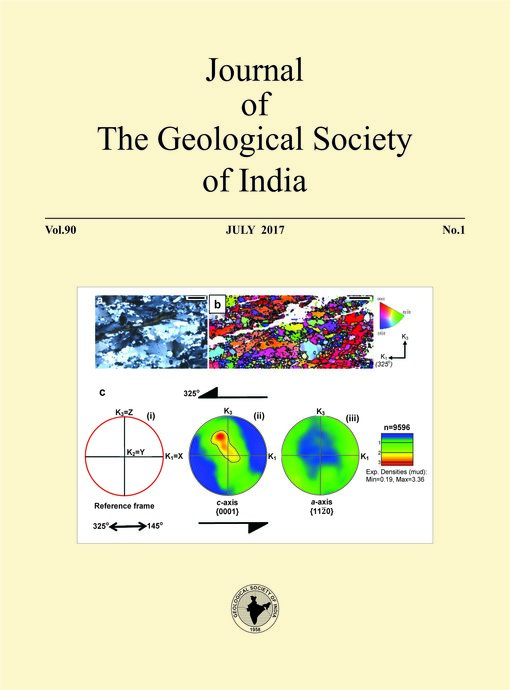Determining the Reference Frame for Kinematic Analysis in S-tectonites Using AMS
DOI:
https://doi.org/10.1007/s12594-017-0657-0Abstract
In this paper a methodology based on anisotropy of magnetic susceptibility (AMS) measurements is presented to identify XZ section of the strain ellipsoid in order to perform kinematic analysis in S-tectonites, which are rocks that lack stretching lineation on the foliation plane. The similarity between orientations of three principal axes of the AMS ellipsoid (K1>K2>K3) and strain ellipsoid (X>Y>Z) is demonstrated by discussing the case of a mylonite (LS-tectonite) that contains both foliation and stretching lineation. Subsequently, the case of S-tectonite from the peninsular gneiss (south India) is discussed, where the K1K3 plane of AMS ellipsoid is equated with XZ section of strain ellipsoid. Quartz crystallographic preferred orientations are investigated using SEM-EBSD studies in thin section prepared parallel to the K1K3 plane. Quartz c-axis patterns characteristic of rhomb slip and indicating top-to-325° sense of shear are recorded. This supports the movement sense inferred by earlier researchers from northern parts of the sampled locality. Thus the usefulness of AMS in determining the reference frame for kinematic studies in S-tectonites is documented.Downloads
Metrics
Issue
Section
Downloads
Published
How to Cite
References
Bhatt, S., Rana, V. and Mamtani, M.A. (2017) Deciphering relative timing of fabric development in granitoids with similar absolute ages based on AMS study (Dharwar Carton, South India). Jour. Struct. Geol., v.94, pp.32-46.
Hrouda, F.(1993) Theoretical models of magnetic anisotropy to strain relationship revisited. Physics Earth Planet. Inter., v.77, pp.237-249.
Lahiri, S. and Mamtani, M.A. (2016) Scaling the 3-D Mohr circle and quantification of paleostress during fluid pressure fluctuation–Application to understand gold mineralization in quartz veins of Gadag (southern India). Jour. Struct. Geol.,v.88, pp.63-72.
Majumder, S. and Mamtani, M.A. (2009) Magnetic fabric in the Malanjkhand Granite (central India) – implications for regional tectonics and Proterozoic suturing of the Indian shield. Physics Earth Planet. Inter., v.172, pp.310-323.
Mamtani, M.A. (2014) Magnetic fabric as a vorticity gauge in syntectonically deformed granitic rocks. Tectonophysics, v.629, pp.189-196.
Mamtani, M.A. and Greiling, R.O. (2005) Granite emplacement and its relation with regional deformation in the Aravalli Mountain Belt (India) - inferences from magnetic fabric. Jour. Struct. Geol., v.27, pp.2008-2029.
Mamtani, M.A. and Sengupta, P. (2010) Significance of AMS analysis in evaluating Superposed Folds in Quartzites. Geol. Magz.,v.147, pp.910-918.
Mamtani, M.A., Pal, T. and Greiling, R.O. (2013) Kinematic analysis using AMS data from a deformed granitoid. Jour. Struc. Geol., v.50, pp.119-132.
Mamtani, M.A., Greiling, R.O., Karanth, R.V. and Merh, S.S. (1999) Orogenic deformation and its relation with AMS fabric - an example from the southern Aravalli mountain belt, India. In: T. Radhakrishna and J.D. Piper (Eds.), The Indian subcontinent and Gondwana: a palaeomagnetic and rock magnetic perspective. Mem. Geol. Soc. India, no.44, pp.9-24.
Mamtani, M.A., Piazolo, S., Kontny, A., Greiling, R.O. and Hrouda, F. (2011) Process of magnetite fabric development during granite deformation. Earth Planet. Sci. Lett., v.308, pp.77-89.
Mondal, T.K. and Mamtani, M.A. (2013)3-D Mohr circle construction using vein orientation data from Gadag (southern India) – implications to recognize fluid pressure fluctuation. Jour. Struct. Geol., v.56, pp.45-56.
Mondal, T.K. and Mamtani, M.A. (2014)Fabric analysis in massive rocks of the Gadag region (southern India) – implications to decipher time relationship between regional deformation and gold mineralization. Tectonophysics, v.629, pp.238-249.
Mondal, T.K. and Mamtani, M.A. (2016) Palaeostress analysis of normal faults in granite; implications for interpreting Riedel shearing related to regional deformation. Jour. Geol. Soc., London, v.173, pp.216-227.
Mukherji, M.A., Chaudhuri, A.K. and Mamtani, M.A. (2004) Regional scale strain variations in Banded Iron Formations of eastern India: results from anisotropy of magnetic susceptibility studies. Jour. Struct. Geol., v.26, pp.2175-2189.
Passchier, C.W. and Trouw, R.A.J. (2005) Microtectonics, 2nd Edition, Springer-Verlag, Berlin.
Renjith, A.R., Mamtani, M.A. and Urai, J.L. (2016) Fabric analysis of quartzites with negative magnetic susceptibility - does AMS provide information of SPO or CPO of quartz? Jour. Struct. Geol., v.82, pp.48-59.
Sen, K. and Mamtani, M.A.(2006) Magnetic fabric, shape preferred orientation and regional strain in granitic rocks. Jour. Struct. Geol., v.28, pp.1870-1882.
Sen, K., Majumder, S. and Mamtani, M.A. (2005) Degree of magnetic anisotropy as a strain intensity gauge in ferromagnetic granites. Jour. Geol. Soc., London, v.162, pp.583-586.
Tarling, D.H. and Hrouda, F.(1993) The Magnetic Anisotropy of Rocks. Chapman and Hall, London.

 Manish A. Mamtani
Manish A. Mamtani






